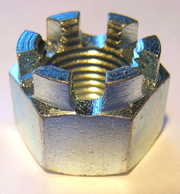Castellated nut: Difference between revisions
Appearance
Content deleted Content added
Rescuing orphaned refs ("barret" from rev 513470095) |
Rvv |
||
| Line 1: | Line 1: | ||
[[Image:Castellated Nut (new).png|thumb|right|180px|Castellated nut]] |
|||
| ⚫ | [[ |
||
[[Image:Car hub cotter pin.jpg|thumb|A car hub, with the central nut hidden behind a castellated ''nut cover'' that is locked against rotation using a cotter pin. The effect is similar to using a castellated nut.]] |
|||
A '''castellated nut''', also called a '''castle nut''' or '''slotted nut''', is a [[nut (hardware)|nut]] with slots (notches) cut into one end.<ref name="barret">{{Citation | last = Barrett | first = Rich | title = Fastener Design Manual | url = http://ntrs.nasa.gov/archive/nasa/casi.ntrs.nasa.gov/19900009424_1990009424.pdf}}.</ref> The name comes from the nut’s resemblance to the [[crenellated]] parapet of a [[medieval castle]]. |
|||
| ⚫ | The [[Screw|bolt]] or axle has one or two holes drilled through its threaded end. The nut is [[torque]]d properly and then, if the slot isn't aligned with the hole in the fastener, the nut is rotated to the nearest slot. The nut is then secured with a [[cotter pin]] or [[safety wire]].<ref name="barret"/> |
||
Castellated nuts are used in low-torque applications, such as holding a [[Rolling-element bearing|wheel bearing]] in place.<ref name="barret"/> |
Castellated nuts are used in low-torque applications, such as holding a [[Rolling-element bearing|wheel bearing]] in place.<ref name="barret"/> |
||
Revision as of 21:02, 20 October 2012


A castellated nut, also called a castle nut or slotted nut, is a nut with slots (notches) cut into one end.[1] The name comes from the nut’s resemblance to the crenellated parapet of a medieval castle.
The bolt or axle has one or two holes drilled through its threaded end. The nut is torqued properly and then, if the slot isn't aligned with the hole in the fastener, the nut is rotated to the nearest slot. The nut is then secured with a cotter pin or safety wire.[1]
Castellated nuts are used in low-torque applications, such as holding a wheel bearing in place.[1]
References
- ^ a b c Barrett, Rich, Fastener Design Manual (PDF).
